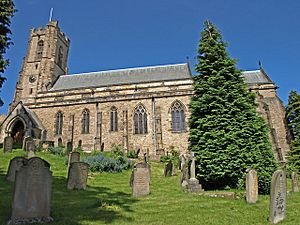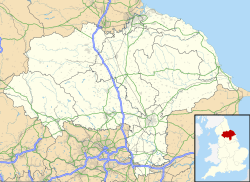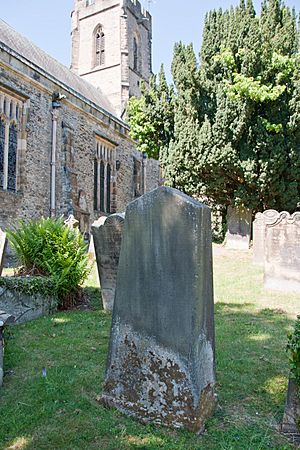Church of St Mary the Virgin, Richmond facts for kids
Quick facts for kids Church of St Mary the Virgin, Richmond |
|
|---|---|
| Parish Church of St Mary, Richmond | |

St. Mary the Virgin, Richmond
|
|
| 54°24′17″N 1°43′58″W / 54.4047°N 1.7329°W | |
| OS grid reference | NZ174010 |
| Location | Richmond, North Yorkshire |
| Country | England |
| Denomination | Church of England |
| Weekly attendance | 100 (2018 benefice average) |
| History | |
| Status | Active |
| Architecture | |
| Architectural type | Perpendicular Gothic |
| Specifications | |
| Bells | Eight |
| Administration | |
| Parish | Richmond with Hudswell (460359) |
| Benefice | Richmond with Hudswell, Downholme and Marske |
| Deanery | Richmond |
| Archdeaconry | Richmond and Craven |
| Diocese | Leeds |
The Church of St Mary the Virgin, Richmond is a historic church in Richmond, North Yorkshire, England. It is the main church for the area. Long ago, there was another church called the Church of the Holy Trinity. It was once a chapel and later became a museum for the Green Howards army regiment.
St Mary's Church has a long history. Its ownership changed from monks to the King, and then to different bishops. Today, it is part of the Diocese of Leeds. The churchyard has some interesting features, like a special burial spot from a time of plague and graves of soldiers from the Battle of Waterloo. The first building for Richmond School was also once located here.
The church stands on a hill that gently slopes down towards the River Swale. St Mary's has been updated many times, especially in the 1800s. It is now a grade II* listed building, which means it is a very important historical site.
Contents
History of St Mary's Church
The Church of the Holy Trinity was once thought to be the main church in Richmond. This was because it was inside the castle walls. But as Richmond grew, St Mary's became the more important church. The two churches were only about 300 metres apart. Holy Trinity Church stopped being used for services in the 1960s. Since the early 1970s, it has been home to the Green Howards Regimental Museum. St Mary's Church now has their special Regimental Chapel.
Some historians believe Holy Trinity was never the main church because it didn't have a burial ground. A book called History of Richmond says Holy Trinity was too small. So, a new church was built on a hill, outside the town walls. This new church was St Mary's. Before a big change called The Reformation, other religious places like Easby Abbey were more important than both churches.
Building the Church
St Mary's Church was built on a slope leading down to the River Swale. This part of the river is known as Clink Pool. A bridge called Mercury Bridge was built in 1846. This made it easier to get to the town from the train station.
Parts of the church, like the nave and aisles, were built in the mid-1100s. However, many changes over the years have made the church look very different from its original design. Some of the stone columns inside might even be older than the 1100s church.
The church tower is about 24 metres tall. It was built around 1399–1400 by the Earl of Westmorland. The font, which is used for baptisms, is from around the same time. The tower has strong supports on its corners. The font is made from a special stone called Teesdale Marble. This stone has many fossils in it and was popular for building churches and abbeys in the late 1300s and early 1400s.
Changes Over Time
Before The Reformation, the church windows showed pictures from the Bible. But after The Reformation, these pictures were seen as "superstitious." So, they were removed or replaced with plain glass. Many additions were made to the church in the 1400s. This led to the church being described as having a Perpendicular architectural style. However, other parts of the building still show the older Gothic style.
Inside the church are twelve special wooden seats called misericords. They came from Easby Abbey and are from the early 1500s. These seats have interesting carvings, like a pig playing bagpipes for two piglets, and a dragon stealing a goose. After the Dissolution of the Monasteries, religious carvings and items were often moved from abbeys to churches. These misericords are at least from 1515. One of them has the shield of Abbot Bampton, who became the head of Easby Abbey in 1515. Other items from the abbey, like choir stalls and some bells, were also moved to St Mary's.
Between 1858 and 1859, the church was renovated by Sir George Gilbert Scott. This work cost about £1,200. In 1890, a stone item was found in the churchyard and placed near the pulpit. People believe this was the original font from an even older church in Richmond. More changes happened in 1892, including a new floor in the chancel and a new window to let in more light. In 1897, C. Hodgson Fowler oversaw more renovations. The most noticeable change was a new, steep roof made of slates. Before this, the roof was flat.
In March 2017, the church's bells were replaced. Eight new bells were made by John Taylor & Co in Loughborough. The old bells, from around 1500 and 1697, were replaced to make bellringing easier and to protect the tower. One of the old bells is still kept in the bell tower. The bellringers at St Mary's are known for teaching others how to ring bells. The bells are rung for special local and national events.
The church organ was first put in the north chapel in 1811. It was replaced in 1912 with one built by Harrison & Harrison. This second organ was fully repaired in 2003.
Regimental Chapel
St Mary's Church has a special chapel for the Green Howards army regiment. Each spring, a service is held there for former members of the regiment. The chapel was created after money was raised in 1931. St Mary's has been the official church for the army garrison and regiment since the early 1800s. The chapel has regimental flags hanging from the ceiling. It also has items from the First World War and an altar rail dedicated to two lieutenants who died in 1915 and 1917. The Green Howards are now part of the modern Yorkshire Regiment. The Royal Lancers army regiment now also uses the chapel for their services.
The chapel and the rest of the church are decorated with memorials. These remember soldiers who died in battle or were important members of the Green Howards. A stone tablet on one wall remembers those who died from 1916 to 1919. It lists them under the name Yorkshire Regiment, which was another name for the Green Howards.
Churchyard Features
The churchyard is a burial ground with many interesting stories. It holds the graves of two soldiers who fought at Waterloo. It also has the grave of Robert Willance, a local businessman. In 1606, Willance broke his leg in a hunting accident. His amputated leg was buried in the churchyard. Ten years later, when he died, he was buried with his leg.
The churchyard also has a special "plague stone." This stone marks where 1,072 people were buried after dying from the Black Death between 1597 and 1599. Another 700 people were buried here after a plague hit the town in 1644 and 1645. A very sad 574 people were buried in just six months during that time.
In 1816, a young poet named Herbert Knowles published his poems called Stanzas in a Richmond Churchyard. Knowles had been a student at Richmond School. He died not long after his poetry was published. In 1861, a bishop ordered a tombstone to be removed from a grave. It had a Latin phrase that was not allowed at the time. The family refused to remove it, so the church authorities did it themselves.
At the north-eastern entrance to the churchyard, there is a high wall and railings. These are also listed as a grade II listed historical feature.
Richmond School's Connection
The first building for Richmond School was built around 1392. It was located on the eastern side of the churchyard. Maps from as early as 1610 show it there. The school moved to a new site across the road in the 1670s. This building was used for schooling until 2012. The school and the church have always had a close connection. Many former headteachers of the school are buried or have memorials in the church grounds.
Church Community and Leadership
The church community, or parish, of Richmond includes St Mary's Church and the church of St Michael and All Angels in Hudswell. In 2018, about 100 people attended services each week.
In 1137, the Earl Stephen gave the "churches of Richmond" to St Mary's Abbey in York. The church was managed by the Priory of St Martin, which was also connected to St Mary's Abbey. After the Dissolution of the Monasteries, the King took control of the church. Later, it was managed by the Bishop of Chester. Today, the church is part of the Archdeaconry of Richmond and Craven, which is in the Diocese of Leeds.
Church Leaders (Vicars)
Leaders of St Mary's, called vicars, have been recorded since 1250. This list comes from church records.
| Year | Incumbent | Year | Incumbent | Year | Incumbent | Year | Incumbent | |||
|---|---|---|---|---|---|---|---|---|---|---|
| 1250 | Peter Chaplain | 1465 | Oliver Bland | 1700 | Robert Booth | 1907 | Nevill Egerton Leigh | |||
| 1316 | Nicholas de Kirkeby | 1473 | Robert Mason | 1705 | William Lupton• | 1927 | Arnold Moon Sullivan | |||
| 1280 | William Clericus | 1554 | Edward Gretehead♦ | 1706 | Thomas Brooke | 1940 | Sheffield G B Exham | |||
| 1317 | Thomas Sleight | 1568 | Thomas Ford | 1739 | Francis Blackburne† | 1945 | William Stuart Macpherson‡ | |||
| 1318 | John Sleight | 1569 | Anthony Ford | 1789 | Thomas Leighton♦ | 1954 | Peter de la Poer Beresford-Peirse | |||
| 1322 | Robert Bouges | 1573 | Nicolas Stonell | 1789 | Christopher Goodwill | 1962 | David H Sillar | |||
| 1340 | John de Bek | 1582 | Edmund Sitheby | 1822 | William Barnes | 1974 | Christopher Norman Hessler White | |||
| 1353 | Hugo de Frithby | 1585 | Anthony Jackson | 1838 | Robert Meek | 1976 | Christopher Norman Hessler White | |||
| 1366 | Robert de Akesgarth | 1620 | Thomas Rokeby | 1843 | Frederick Scott Surtees | 1998 | Richard Cooper• | |||
| 1369 | John Harwood | 1639 | George Fernly | 1850 | Lawrence Ottley† | 2009 | John Chambers• | |||
| 1443 | Robert Eston | 1649 | Thomas Hill | 1861 | Richard E Roberts | 2017 | Martin Fletcher | |||
| 1449 | Hugh Walker | 1658 | John Kearton | 1890 | William Danks‡ | |||||
| 1462 | Robert Mason | 1664 | Richard Godvalve | 1897 | Ludovick Stuart Robinson |
- † Died in office
- • Retired or resigned
- ‡ Became Archdeacon of Richmond during their incumbency
- ♦ Interregnum between incumbent and previous when dates are incorrect, period appears too long or records are incomplete.
Since November 1, 1897, when Ludovick Stewart Robinson became the vicar at St Mary's, every vicar after him has also been in charge of the Holy Trinity Chapel.




